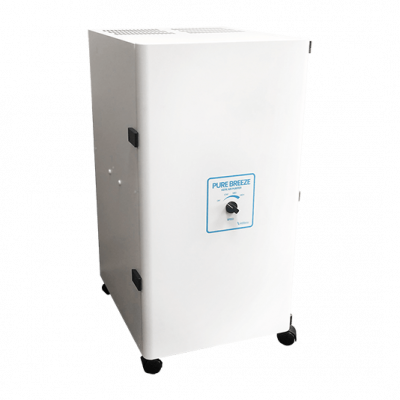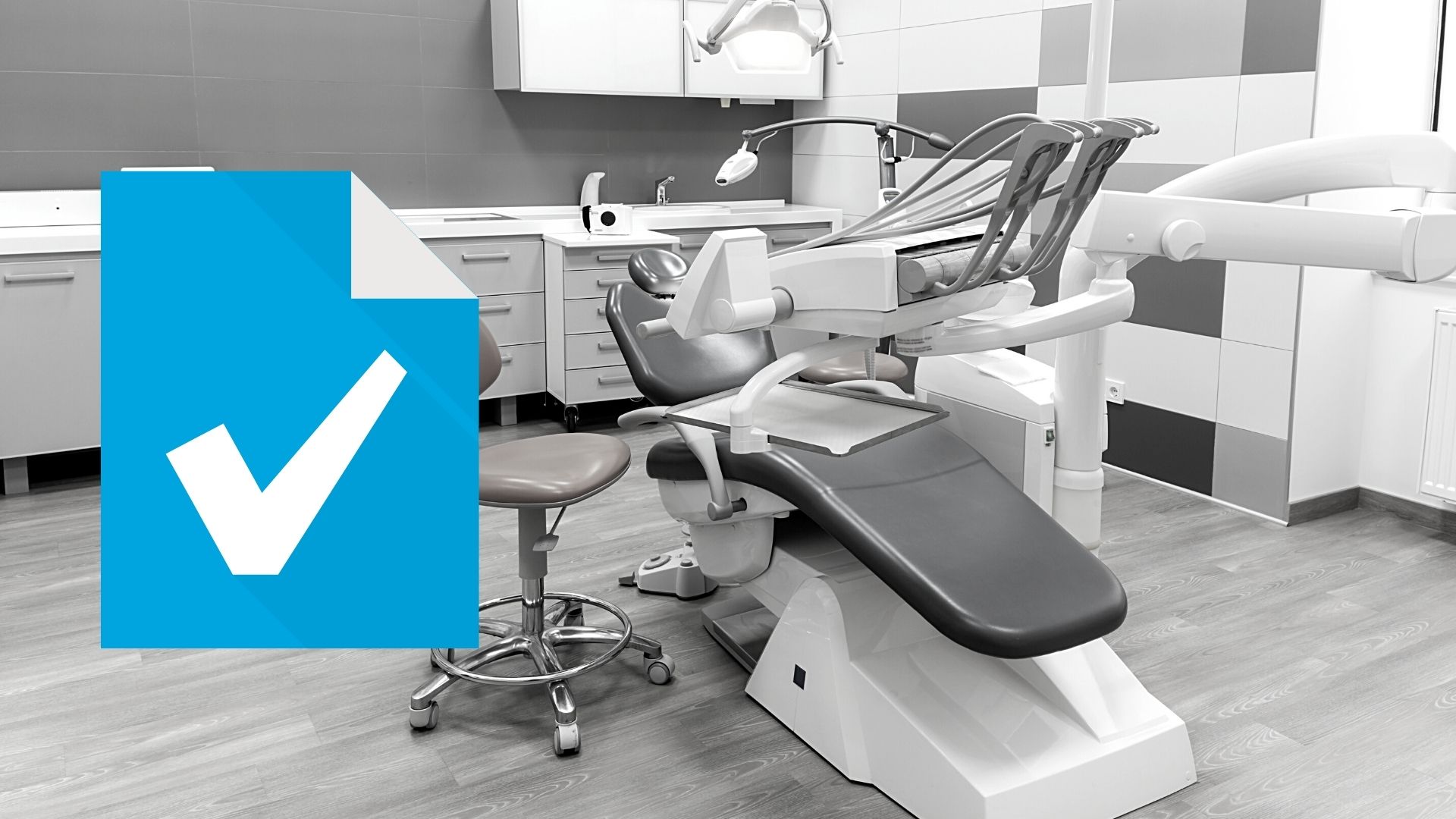
HEPA air purification systems are often misplaced in dental offices and labs. Use this guide to properly place your HEPA air purifier.
Dental staff and equipment dealers are rarely educated on the nuances of where to place air filtration devices in dental settings.
(For a TL;DR version click here.)
Indoor air quality is important.
According to the World Health Organization, 4 million people die each year from indoor air pollution.
Research published in the journal, Science of the Total Environment, has shown indoor air to be 2-5 times more dangerous than outdoor air. Add an additional hazard such as smoking and those numbers jump to over 100.
Sure, no one is dropping dead or rushed to hospital after breathing bad air but keep this in mind; related deaths and illnesses are typically from long-term exposure.
How well do dental offices and dental labs fair when it comes to air quality and health?

Well… Horribly.
The US Department of Labor ranked the dental profession as the #1 unhealthiest career in America.
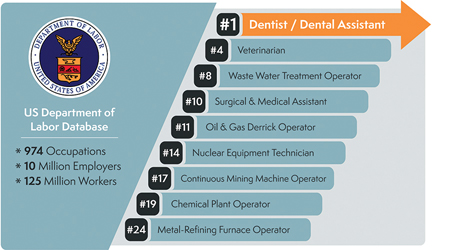
On the other hand, it’s also ranked second in best jobs to have, #1 in best healthcare jobs, #2 in best STEM jobs, and #10 in best paying jobs according to U.S. News & World Report.
No risk no reward it would seem.
So, what’s the best way to mitigate that risk?
Simple: Use a HEPA Air Purifier to dramatically improve air quality.
Air quality and aerosols are the biggest threat to a dental health care professional’s health.
There’s significant research to back up this claim:
As recent as June 19th, the CDC emphasized that “ventilation systems that provide air movement in a clean-to-less-clean flow direction reduce the distribution of contaminants and are better at protecting staff and patients”.
Multiple published studies(1-4) prove the efficacy of HEPA air purifiers in dental settings.
The recent pandemic has highlighted the need for dental air purifiers however units can be nearly ineffective if not properly placed.
That that sink in for a minute…
“the efficiency of any in-room air cleaner is its strategic placement and set-up within a room, which should be done in consultation with ventilation engineers, infection control experts, and/or industrial hygienists.”
U.S. National Library of Medicine, National Institute of Health
A poorly positioned air cleaner may disrupt airflow patterns in the room which compromises its air cleaning efficiency.
Not to worry!
Vaniman has been involved with the research and engineering of air quality and management for over 30 years.
This guide will help you place your air purifier system in your dental office or lab.
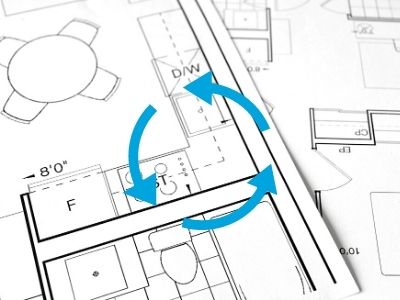
The main thing you’re looking to do with a filtration system is filter out the bad stuff and replace it with good clean air.
To do this, the system needs to capture dirty air, filter it, then expel the clean air.
There are several factors that affect how well this is done with any HEPA Air filtration device.
Let’s cover some basic concepts.

Basic terminology and concepts for proper air filtration device placement.
There are several terms and acronyms that you run into when talking about air filtration.
“CFM” or cubic feet per minute which is how much air, in volume, a filtration device will move.
“ACH” stands for Air Changes Per Hour and is determined using a formula based on device CFM and the dimensions of a room (you can use our Air Changes Per Hour Calculator Tool here).
Room volume or “Vol”, as it’s used in calculations, is the cubic square feet of air volume in a room. This is determined by calculating the length, width, and height of a room.
Another term you may see is “CADR” or Clean Air Delivery Rate. It’s a rating given by the Association of Home Appliance Manufacturers that measures efficiency of the filter system.
The rating is calculated by comparing the CFM of a device by how effectively it filters various particles and is mostly used for home-based appliances.
“HEPA” is an acronym for High Efficiency Particulate Air. HEPA filters are used in most air purifiers and are the ideal filter classification you’ll need for any air purifier.
Many people get caught up in the various levels of HEPA filtration…
The only thing a dental professional will need to be concerned with in these scenarios is using a true HEPA filter.
The HEPA indication is provided by the filter manufacturer who test to verify filters meet HEPA filtration standards.
These standards equal 99.97% efficiency at 0.3 Micron. This captures viruses, aerosols, dust, you name it.
If you’re looking for more detailed information about the capturing ability of HEPA filters, check out our blog titled “Do HEPA air purifiers filter out the COVID-19 virus?“.
The bottom line is that a HEPA filter in your device is sufficient for air filtration needs.
No need for bells, whistles, and other marketing gimmicks.
With basic terminology out of the way, we can dive into the key factors for proper selection and placement of your HEPA air purifier device.

Step by step process for proper air purifier placement in your dental office or lab.
To correctly place an Air Purifier in a dental office or lab, use the following steps:
- Step 1: Identify which rooms require air filtration.
- Step 2: Find and note the location of HVAC return and supply vents and their direction of air flow.
- Step 3: Determine the proper ACH rate for each room.
- Step 4: Calculate the total volume of air in each room.
- Step 5: Identify your HEPA Air Purifier device CFM rating and direction of airflow.
- Step 6: Place air purifier units in rooms where proper ach rate is achieved and clean air flow from the device does not cause turbulence with supply vents.
Let’s break down each section below.
How to determine which rooms needs air filtration in your dental office or lab.
Ideally, each room should have proper air filtration for the amount of air in the room.
In cases where this is not possible, air purifiers should be prioritized in areas where aerosols and airborne transmission is highest.
These include waiting areas, operatories, workstations, etc.
If you cannot place an air purifier in each room combine adjacent room dimensions or total air volume to calculate ACH rates.
How to determine if an HVAC vent is for air return or air supply.
Next, we need to find which HVAC vents are supply vents and which are return vents.
This is important because supply and return vents can affect the air flow in the room and capabilities of the air purifier if turbulence occurs..
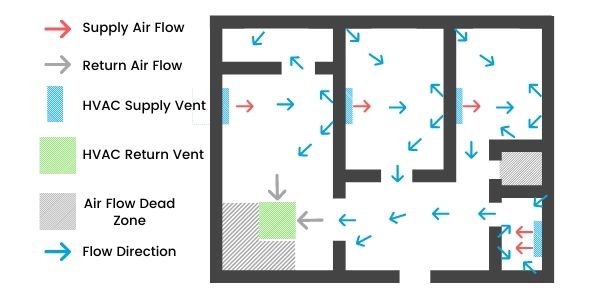
Supply Vents
Supply vents push the air into the each room and you will typically find one in each room.
How to identify a HVAC air supply vents.
- Air supply vents are usually the smaller vents with louvers or slates.
- When the fan for the HVAC system is turned on, hold a piece of paper up to the vent; the paper should blow away from the vent if it is a supply vent.
Return Vents
Return vents pull the building air into the HVAC system through a filter and then redistributes the air using the supply vents.
How to identify HVAC air return vents.
- Return vents are usually larger and have a filter located behind their grill or covering.
- When the fan for the HVAC system is turned on, hold a piece of paper up to the vent; the paper will pull towards the vent if it is a return vent.
Placing an air purifier directly below a return vent will result in the filtered air going into the HVAC system. This can work well in small locations but is not ideal in larger facilities.
Once you know where your return and supply vents are located, you can begin to understand the general airflow of the building. Take note of these locations as we will need them later.
How to determine how many air changes per hour are needed for dental offices and labs.
The CDC provides a chart with recommended ACH rates for dental settings.
Use the chart below to find the proper ACH rate for each dental room.
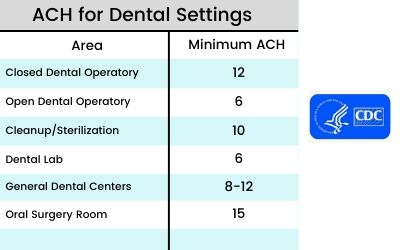
How to calculate the total volume of air for each room.
Calculate the total air volume by multiplying the length, width, and height of the room. We’ll use a common dental operatory room to illustrate this.
A common operatory room is 11 ft. wide, 12 ft. long, and 10 ft. in height. So, 11x12x10 = 1320 cubic ft. of air or “Vol” as it’s used air calculation formulas.
Use the calculator below to quickly find the total air volume for any room.
HEPA Air Purifier Specification and Air Supply Method

Purchasing the wrong equipment without considering your air volume needs first can cause major issues.
After all, the entire point of purchasing a HEPA Air purifier system is to properly clean the air. You simply won’t be able to achieve this with improperly matched systems.
Select an air purifier with enough CFM to achieve your desired ACH rate for the room it’s in.
Use the calculator below to calculate if your air purifier is sufficient for your ACH needs.
After that, you then need place the unit in a location where the direction of clean air flow isn’t affected by a supply vent.
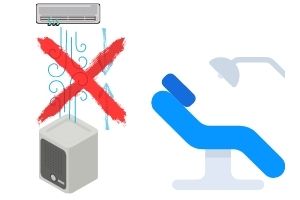
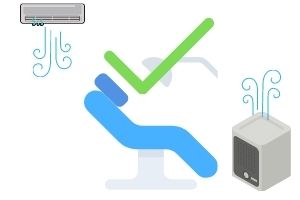
Make sure the system has plenty of access to the room air-avoid corners and tight areas if possible.
When all these factors are taken into consideration, you air purifier system can effectively work to capture and filter adequate amounts of air for your specific needs.
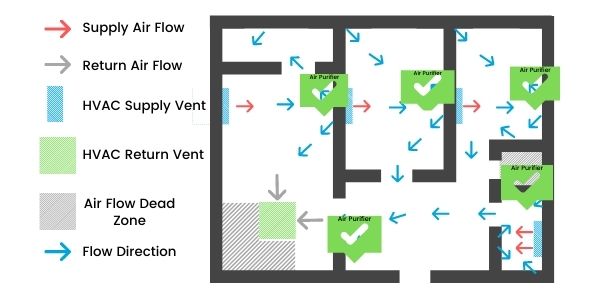
Here’s the TL;DR version:
Use our Air Purifier Placement Worksheet or follow the steps below:
- Step 1: Identify which rooms require air filtration.
- Step 2: Find and note the location of HVAC return and supply vents and their direction of air flow.
- Step 3: Determine the proper ACH rate for each room.
- Step 4: Calculate the total volume of air in each room.
- Step 5: Identify your HEPA Air Purifier device CFM rating and direction of airflow.
- Step 6: Place air purifier units in rooms where proper ach rate is achieved and clean air flow from the device does not cause turbulence with supply vents.
- Use our ACH calculator tool to help with this process.
If you need further information regarding how to place your air purifier system, please contact our air filtration specialists today at 1-800-VANIMAN.
If you’re in the market for a USA assembled HEPA Air Cleaner, please consider our Pure Breeze product. It’s know to be extremely reliable, quiet, and capable of providing excellent ACH rates thanks to a high quality turbine motor.
References
- Zeisler J. Cleaner air in the dental office. Ontario Dentist. 2009;9:28-29.
- Chen C, Zhao B, Cui W, Dong L, An N, Ouyang X. The effectiveness of an air cleaner in controlling droplet/aerosol particle dispersion emitted from a patient’s mouth in the indoor environment of dental clinics. J R Soc Interface. 2010;7(48):1105-1118.
- Helmis GC, Tzoutzas J, Flocas HA, et al. Indoor air quality in a dentistry clinic. Sci Total Environ. 2007;377(2-3):349-365.
- Hallier C, Williams DW, Potts AJ, Lewis MA. A pilot study of bioaerosol reduction using an air cleaning system during dental procedures. Br Dent J. 2010;209(8):E14.
- Additional citation and references are linked in blue throughout article.

